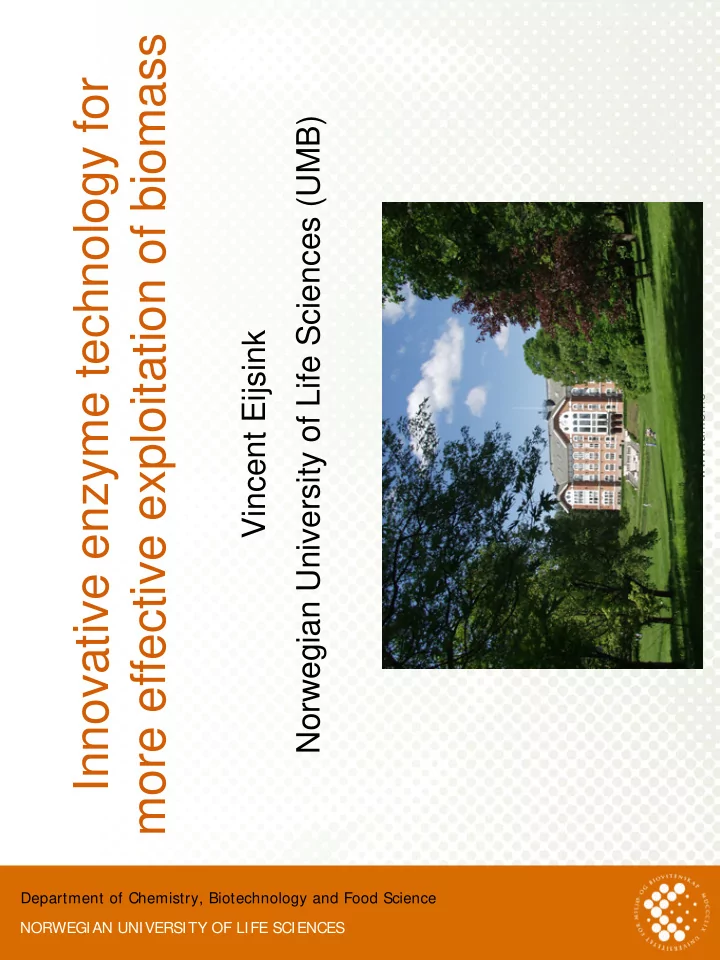

more effective exploitation of biomass Innovative enzyme technology for Norwegian University of Life Sciences (UMB) Vincent Eijsink www.umb.no Department of Chemistry, Biotechnology and Food Science NORWEGIAN UNIVERSITY OF LIFE SCIENCES
The biobased economy www.umb.no Department of Chemistry, Biotechnology and Food Science NORWEGIAN UNIVERSITY OF LIFE SCIENCES
NORWEGIAN UNIVERSITY OF LIFE SCIENCES Department of Chemistry, Biotechnology and Food Science The biobased economy: Using renewable materials as source for energy, chemical and materials. Some key R&D challenges: � We need to understand our raw materials (plants, seaweeds, by-products) � We need chemical or enzymatic conversion technologies www.umb.no
NORWEGIAN UNIVERSITY OF LIFE SCIENCES Department of Chemistry, Biotechnology and Food Science Key technology: enzymatic processing Enzymes are great! � Mild conditions � Precise (no by-products) � Catalyze almost any reaction � Can be engineered � Non-toxic, natural, degradable BUT: (most) enzymes are expensive www.umb.no
NORWEGIAN UNIVERSITY OF LIFE SCIENCES Department of Chemistry, Biotechnology and Food Science Enzymology – applied projects UMB Chitin/ Production of CHOS Chitosan Protein and Protein hydrolysates more Prebiotics, Protein Proteins, hydrolysates Carbohydrates Cellulose Sugar, ethanol, gas Hemicellulose www.umb.no
Key process: biomass deconstruction From biomass to monosugars - the central starting point for in the ”biorefinery”. www.umb.no (saccharification) Department of Chemistry, Biotechnology and Food Science NORWEGIAN UNIVERSITY OF LIFE SCIENCES
NORWEGIAN UNIVERSITY OF LIFE SCIENCES Department of Chemistry, Biotechnology and Food Science The biorefinery, 2nd generation biofuels and enzymes – Notes � Enzymatic deconstruction is the method of choice. � Enzymes are a major cost. � Biofuel is only one of many possible products. � Enzymes are also crucial in other steps of the biorefining process. � Nutrient recycling is crucial. www.umb.no
enzymes do the job. � Could there be a Classic “dogma”: processive “Exo” � Does this make missing link? Enzymatic conversion of recalcitrant “Endo” and sense? www.umb.no polysaccharides: Department of Chemistry, Biotechnology and Food Science NORWEGIAN UNIVERSITY OF LIFE SCIENCES
NORWEGIAN UNIVERSITY OF LIFE SCIENCES Department of Chemistry, Biotechnology and Food Science Innovative enzyme technology Tibtech 26:228-235 (2008) Through long-term research on chitin and chitinases we have gained novel insights in biomass-converting enzymes which is now applied to lignocellulosic biomass. www.umb.no
Unravelling the role of processivity Picture: NREL Picture: NREL www.umb.no Department of Chemistry, Biotechnology and Food Science NORWEGIAN UNIVERSITY OF LIFE SCIENCES
Gustav Vaaje-Kolstad et al., Journal of Biological Chemistry 280: 11313 - The discovery of accessory proteins 11319 & 280:28492-28497 (2005) + Patent application www.umb.no Department of Chemistry, Biotechnology and Food Science NORWEGIAN UNIVERSITY OF LIFE SCIENCES
NORWEGIAN UNIVERSITY OF LIFE SCIENCES 12 UMN-UMB, Team 4 project Designer proteins for efficient enzymatic degradation of recalcitrant cellulose Goals: Use of directed evolution to produce accessory proteins � that act on cellulose. Generation of fundamental knowledge about how � helper proteins such as CBP21 work. People: Claudia Schmidt-Dannert group with post-doc Jake � Vick. Eijsink group with post-doc Gustav Vaaje-Kolstad and � (since 2010) Ph.D. student Zarah Forsberg. www.umb.no
NORWEGIAN UNIVERSITY OF LIFE SCIENCES 13 UMN-UMB, Team 4 – Status � A screening assay has been developed (a major time investment) (UMN). � Mutant libraries have been constructed and novel ones are under construction (UMN). � Library screening has yielded the first interesting mutants: other binding preferences, changed activities (UMN). www.umb.no
NORWEGIAN UNIVERSITY OF LIFE SCIENCES 14 UMN-UMB, Team 4 – Status � Mutants are being tested in detail; researcher exchanges (UMN & UMB). � More mutants are being selected (UMN). � Biophysical characterization and structural work using solid state NMR (UMN & UMB). � Novel mechanistic insights (UMB). � Novel wild-type accessory proteins are being produced and characterized (UMB) www.umb.no
NB! GH61 proteins are abundant in cellulose degrading fungi GH61 Novel developments – GH61 www.umb.no CBP21 Department of Chemistry, Biotechnology and Food Science NORWEGIAN UNIVERSITY OF LIFE SCIENCES
Novel developments – unravelling of the mechanism and boosting of activity Science, Oct 8, 2010, Vol 330, pp 219-222 www.umb.no Department of Chemistry, Biotechnology and Food Science NORWEGIAN UNIVERSITY OF LIFE SCIENCES
www.umb.no Department of Chemistry, Biotechnology and Food Science NORWEGIAN UNIVERSITY OF LIFE SCIENCES
www.umb.no Department of Chemistry, Biotechnology and Food Science NORWEGIAN UNIVERSITY OF LIFE SCIENCES
Chain cleavage in a fully crystalline context! GH61 CBP21 A missing link in cellulose degradation www.umb.no Department of Chemistry, Biotechnology and Food Science NORWEGIAN UNIVERSITY OF LIFE SCIENCES
www.umb.no Department of Chemistry, Biotechnology and Food Science NORWEGIAN UNIVERSITY OF LIFE SCIENCES
NORWEGIAN UNIVERSITY OF LIFE SCIENCES Department of Chemistry, Biotechnology and Food Science Concluding remarks The UMB-UMN project is very ”hot”; the partners � have world-leading, complementary expertises. Completely new paradigms for enzymatic biomass � conversion may emerge. Major challenges in the directed evolution part & � lack of labour power have been delaying the joint project; current potential is huge and progress is good. Short line from fundamental research to application. � www.umb.no
NORWEGIAN UNIVERSITY OF LIFE SCIENCES Department of Chemistry, Biotechnology and Food Science Applied bioenergy projects at Ås (Nb. new projects; since 2009) Conversion of wood, straw, bagasse, seaweed to � sugar or ethanol. Conversion of any biomass, household waste, � manure, by-products from food production to methane. Combined, integrated processes. � Industry is heavily involved (Cambi, Borregaard, Statoil, Xynergo, Hafslund, Weyland, SES) Approximately 7 persons (+ more at partners) Institutional collaborations with UMN (Minneapolis) and SLU (Uppsala) www.umb.no
NORWEGIAN UNIVERSITY OF LIFE SCIENCES Department of Chemistry, Biotechnology and Food Science How can we get better? UMN – UMB: More labour power � More intense (regular) contacts, more exchange � Larger network ? � Norway / Nordic: Much more funding for long-term researcher-driven � science in Norway (and Europe) More funding for equipment � Nordic bioenergy initiative ? � www.umb.no
Recommend
More recommend